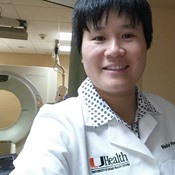Program Information
Quantification of MLC Positioning Accuracy in VMAT Delivery of Head and Neck Cancer Treatment
X Li*, F Yang, University Of Miami, Miami, FL
Presentations
SU-F-T-303 (Sunday, July 31, 2016) 3:00 PM - 6:00 PM Room: Exhibit Hall
Purpose: Knowing MLC leaf positioning error over the course of treatment would be valuable for treatment planning, QA design, and patient safety. The objective of the current study was to quantify the MLC positioning accuracy for VMAT delivery of head and neck treatment plans.
Methods: A total of 837 MLC log files were collected from 14 head and neck cancer patients undergoing full arc VMAT treatment on one Varian Trilogy machine. The actual and planned leaf gaps were extracted from the retrieved MLC log files. For a given patient, the leaf gap error percentage (LGEP), defined as the ratio of the actual leaf gap over the planned, was evaluated for each leaf pair at all the gantry angles recorded over the course of the treatment. Statistics describing the distribution of the largest LGEP (LLGEP) of the 60 leaf pairs including the maximum, minimum, mean, Kurtosis, and skewness were evaluated.
Results: For the 14 studied patients, their PTV located at tonsil, base of tongue, larynx, supraglottis, nasal cavity, and thyroid gland with volume ranging from 72.0 cm³ to 602.0 cm³. The identified LLGEP differed between patients. It ranged from 183.9% to 457.7% with a mean of 368.6%. For the majority of the patients, the LLGEP distributions peaked at non-zero positions and showed no obvious dependence on gantry rotations. Kurtosis and skewness, with minimum/maximum of 66.6/217.9 and 6.5/12.6, respectively, suggested relatively more peaked while right-skewed leaf error distribution pattern.
Conclusion: The results indicate pattern of MLC leaf gap error differs between patients of lesion located at similar anatomic site. Understanding the systemic mechanisms underlying these observed error patterns necessitates examining more patient-specific plan parameters in a large patient cohort setting.
Contact Email:

